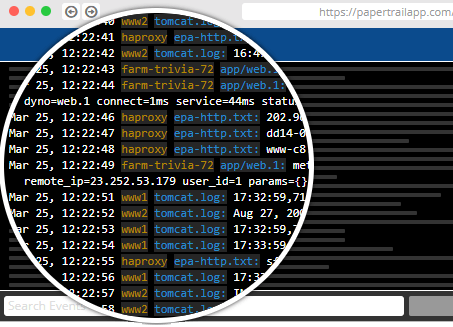Tips from the Team
By engineers, for engineers
At Papertrail we are software engineers who are passionate about programming, debugging, logging and pretty much everything about building and running applications. We enjoy keeping our coding skills sharp and playing with new technologies. Below are some of things we have picked up along the way.
Fully Functional for 14 Days

Tips for Creating the Most Useful Syslog Messages Possible
Tips to Get the Most Out of Your IIS Logs
11 Tools You Should Be Monitoring With Syslog
Free AppOptics Dev Edition (APM for your test environment)
Linux Log Monitoring – Seven Aspects to Pay Attention To
Eleven Tips on How to Get the Most of AWS Logging
Seven Typical Problems With Logging Ruby (And How to Solve Them)
How to Optimize .NET Error Logging
Logging Django Apps Made Easy With Papertrail
Node.js Logging – How to Get Started
Tips for Creating the Most Useful Syslog Messages Possible
Imagine the software you’ve just pushed to production is causing latency spikes for users visiting your web app. Your code passed all the tests but something about running with real-life users has uncovered a bug not previously caught by your automated testing. Now you need to figure out what went wrong and how to fix it.
Tips to Get the Most Out of Your IIS Logs
Wouldn’t it be great if web apps and websites just worked the way they did in testing and staging? Unfortunately, it seems as soon as you release them into the wild, things start going wrong. When you’re getting calls from users or seeing availability alerts, getting your hands on the right data from your IIS logs can make a big difference in how quickly you respond.
11 Tools You Should Be Monitoring With Syslog
Syslog has been around for four decades, and it’s a well-used tool in every DevOps and admin tool kit. The syslog format began as part of the Sendmail project, and it has since become a ubiquitous logging protocol used by hundreds of applications and supported out of the box by most major operating systems. This battle-tested logging format provides all the pieces you need to create actionable log messages and diagnose problems with your apps and services.
Free AppOptics Dev Edition (APM for your test environment)
SolarWinds® AppOptics™ Dev Edition is a free, full-function APM tool for developers and quality assurance teams.
• Test and troubleshoot your application’s performance in a pre-production environment
• Debug distributed applications while they’re in development
• Catch bugs early, and gain full visibility and insight into the applications you’re developing
Linux Log Monitoring – Seven Aspects to Pay Attention To
Monitoring application and Linux system logs is a skill that every seasoned SysAdmin has down cold. Logs provide a window into understanding the health of your systems, and they’re the first place to look when things aren’t working. But no matter how familiar you are with Linux log monitoring, even gurus of the command line can learn new tricks. Whether you’re an old hand or a relative newcomer, here are seven tips on how to monitor log files in Linux that you may have overlooked.
Eleven Tips on How to Get the Most of AWS Logging
Amazon Web Services (AWS) comprises more than 90 services and covers everything from computing and storage to analytics and Internet of Things tools. Using these services to build applications at scale requires constantly monitoring the entire software stack to make sure the wheels keep turning. But it’s when issues arise, and the wheels come off, that every developer puts their AWS logging setup to the test.
Seven Typical Problems With Logging Ruby (And How to Solve Them)
No matter how much logging you collect from other sources, some issues can only be diagnosed with application-level logging. As your application scales and you experience more crashing servers, network failures, and intermittent bugs, logs become even more important. Beyond application details, logs can even include business intelligence data to help you make improved business decisions.
How to Optimize .NET Error Logging
Like most developers, you’ve probably seen the benefits of logging first-hand—the right log message can be the key to unlocking the trickiest of software issues. But not all logging is created equal and actionable logs don’t magically appear. If you want the very best logs, you need to optimize your logging using tried-and-true best practices.
Logging Django Apps Made Easy With Papertrail
Looking for an easy-to-use web framework that provides high-level building blocks to go from concept to production quickly? One popular choice is Django, a Python web development framework originally created at World Online, a newspaper web company for rapidly building and launching websites to support news stories.
Node.js Logging – How to Get Started
Node.js may be the run-time environment that lets you use a single programming language (JavaScript) for both server-side and client-side applications, but it has no shortage of logging methods. Even though there are clearly delineated trade-offs with each of the logging techniques, if you’re a newcomer, it can be difficult to make sense of them and to know which one is right for your environment.